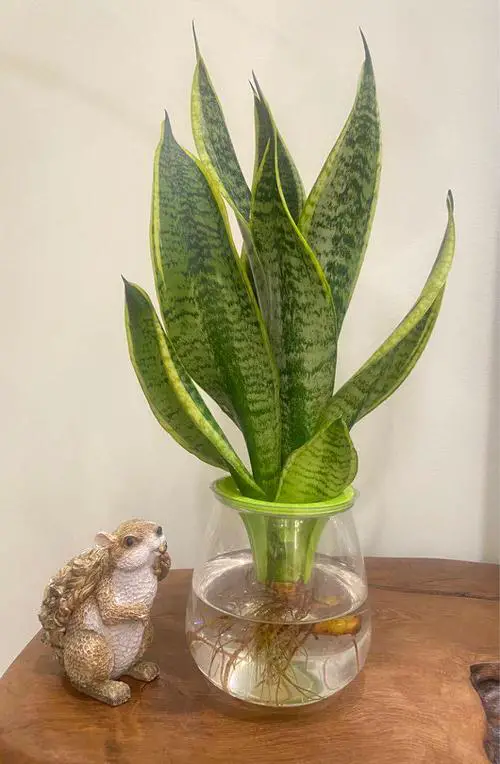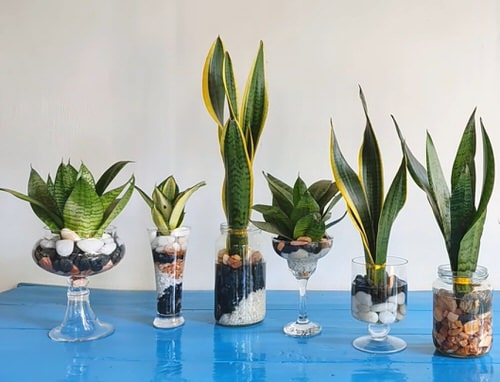Do you want to know How to Grow Snake Plant in Water? We have a detailed guide to help you grow this air-purifying plant with ease!

Sansevierias are one of the most versatile plants you can have indoors. They are easy to maintain and look fantastic with all sorts of decor. If you are someone who is fussy with pots and soil, then here are all the details on How to Grow a Snake Plant in Water to keep things easy and new!
Can Snake Plants Survive in Water?
The answer to this question is–Yes! Sansevierias can survive in water. But it may sound contradictory as snake plants dislike overwatering, which can cause root rot and fungal infection.
However, you can grow it entirely in the water safely without any worries as long as you keep certain points listed below in mind.
Growing Snake Plants in Water
Snake plants can be easily grown in water through leaf cuttings from an existing plant. The process takes 2-3 months until the roots become healthy and strong. After roots are formed, you can continue to grow the snake plants in water.
Keep in mind that most plants have slower growth in water than in soil. This would be the same for the mother-in-law’s tongue plant; this can become a nice centerpiece to keep on a shelf or table, but you may not be able to see much growth.
How to Grow Snake Plants in Water?

You can do this process anytime of the year in your home, which is the best part:
Things You’ll Require:
- Clean, sharp knife or scissors
- Vase or glass jar
- Water
Propagation
- Use a sharp knife or scissors to cut off a healthy and mature leaf from the base.
- Make a clean cut at the bottom—it will boost the chances of success.
- Place the cutting in a transparent jar or vase and fill water, covering about the bottom 25 percent of the leaf-cutting.
- To keep the leaves in place, especially if you are using a small glass, poke toothpicks in them.
- The roots will develop in about one to two months.
- Alternatively, you can also take out a young pup with not so developed roots.
- Wash its roots in running water and arrange it in a vase of water following the above steps. This method is rather more successful than the above, but it’s all about trying and experimenting to find out whatever works for you.
Requirements for Growing Snake Plants in Water

Light
Snake plants do well in bright light. So, avoid keeping the specimen in a dark location. An east-facing window where it can get direct morning sunlight for 2-3 hours every day would be best. Any location with bright, indirect sunlight all day is fine.
Water
Water quality is an important factor while growing snake plants hydroponically. Use rain, pond, well, or RO water. If using tap water, allow it to sit overnight. Change the water every 5-7 days or earlier if it becomes discolored.
Temperature
Water-grown snake plants do best in temperatures between 50-95 F (10-35 C). The plant prefers warm temperatures at least above 60 F (15 C) or higher.
Fertilizer
Use any balanced, water-soluble fertilizer to feed the plant. An addition of just a pinch of fertilizer every third or fourth time when you change the water is usually fine. You can also use aquarium water diluted every once in several weeks.
Some Points to Consider

- Rinse the jar every time when you change the water. It will remove fungi or bacteria from the surface of the jar. Remove the rotten parts or thick brown outer covering of floating aerial roots.
- Snake plants dislike cold weather, hence protecting them from cold drafts. Keep them away from window panes and A/C vents.
- Adding a piece or two of activated charcoal to the vase will keep the water clean.
Where to Keep Water-Grown Snake Plants?

Snake plants in the water will look beautiful on center tables in jars or narrow vases. You can set them on desks, dining tables, and tabletops for an elegant look.



Can already rooted plants be grown I’m h2o if all the soil is removed.
Yes
The first picture of the jar with green plastic ‘bottleneck’, where can I buy it?